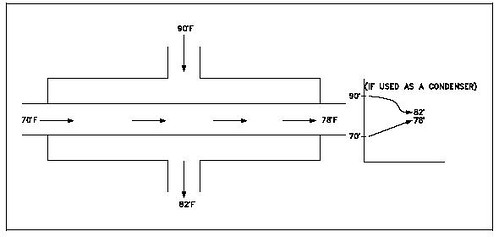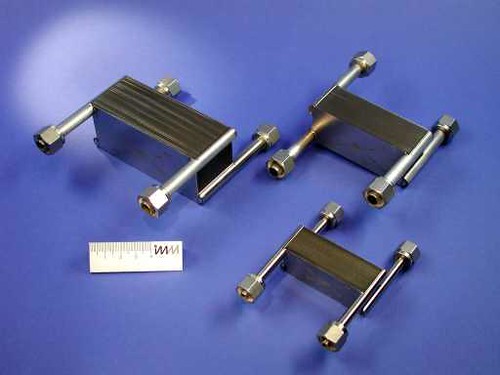Operating Principles:
Micro-scale heat exchangers or micro structured heat exchangers are heat exchangers in which a fluid flows in a lateral direction in a confined area such as a tube or small cavity that dimensions are below the size of 1mm. Typically the fluid flows through a cavity which is called a mirochannel. This technology exploits enhanced heat transfer resulting from structurally constraining streams to flow in microchannels, which reduces resistance to transferring heat. Fluid flowing through the channels on a plate evaporates or condenses, and heat is transferred. Micro heat exchangers have been demonstrated with high convective heat transfer coefficients ranging form 10,000 to 35,000 watts/m2-°C, or about one order of magnitude higher than typically seen in conventional heat exchangers with very low pressure drops, typically 1 or 2 psi. The basic operating principle of these devices goes back to the convective heat transfer within the flows of the microchannels. The convective heat transfer equation is:
(1)In this equation h is the heat transfer coefficient of the microscale heat exchanger, Nu is the Nusselt number which is about 3.65, k is the thermal conductivity of the working fluid and d is the diameter of the microchannel which the fluid flows through. From this equation one can tell see how the size of the channel directly affects the heat transfer coefficient of the heat exchanger, as the diameter is decreased the heat transfer coefficient increases.
Different Types of Microscale Heat Exchangers:
The different types of microscale heat exchangers are the same as the different classifications of conventional heat exchangers. They have either one or two passages for the fluid to flow through.
• One fluid:
When there is only one fluid and one passage in the heat exchanger the fluid is used to transfer the heat to another location. Application of this kind of heat exchangers is usually found in electronics to transfer heat into the fluid and out of the electronic device.
• Two Fluids:
When there are two fluids and two passages they are usually classified by the direction in which the fluids flow by each other. Microscale heat exchangers can either be cross flow or counter flow heat exchangers.
• Counter Flow
Counter flow micro scale heat exchangers work the same way as macro-scale counter flow heat exchangers. In a counter flow heat exchanger the two fluids flow in opposite directions of each other. The fluids enter the heat exchanger at opposite ends. The cooler fluids exits the counter flow microscale heat exchanger at the end where the hot fluid enters therefore the cooler fluid will approach the inlet temperature of the hot fluid. Counter flow microscale heat exchangers are more efficient than cross flow microscale heat exchangers.

Figure 1: Schematic of Counter Flow Heat Exchanger
Figure 2: Counter Flow Microscale Heat Exchangers
• Cross Flow
Cross Flow microscale heat exchangers work the same way as cross flow macro-scale heat exchangers. In a cross flow heat exchanger one fluid flows perpendicular to the second fluid. One fluid flows through tubes or channels and the second fluid passes around the tubes or channels at a 90° angle. Cross flow micro heat exchangers are usually found in applications where one of the fluids changes state therefore having a two-phase flow.

Figure 3: Schematic of a Cross Flow Heat Exchanger
To concurrently achieve the goals of high mass flow rate, low pressure drop, and high heat transfer rates, the microscale cross flow heat exchanger comprises numerous parallel, but relatively short microchannels. The performance of these microscale heat exchangers is superior to the performance of previously available macro-scale heat exchangers. Typical channel heights are from a few hundred micrometers to about 2000 micrometers, and typical channel widths are from around 50 micrometers to a few hundred micrometers. The use of microchannels in a cross flow microscale heat exchanger decreases the thermal diffusion lengths, allowing substantially greater heat transfer per unit volume or per unit mass than has been achieved with other heat exchangers. The cross flow microscale heat exchangers have performance characteristics that are superior to state of the art macro-scale heat exchanger designs.

Figure 4: Cross Flow Microscale Heat exchanger
Advantages over Macro-Scale Heat Exchangers:
• Substantially better performance
- Improves heat transfer coefficient with large number of smaller channels
• Size
- Smaller size allows for an increase in mobility and uses
• Light Weight
- Lower weight reduces the structural and support requirements
• Cost
- Lower costs due to less material being used in fabrication
Disadvantages of Microscale Heat Exchangers:
One of the main disadvantages of microchannel heat exchangers is the high pressure loss that is associated with a small hydraulic diameter. This prevents the uniform flow of the cooling material along the channel. Microchannels are sometimes fairly long and absorb most of the heat along the first section of the channel. This makes them less able to absorb heat along later sections. In order to get the maximum performance out of a microchannel heat exchanger, there needs to be a balance between the desirable high heat transfer coefficient and the undesiarable pressure loss. Due to the small scale of microchannel passages, wall roughness can be very important in determining how high the heat transfer coefficient is.
Applications of Microscale Heat Exchangers:
Microscale heat exchangers are being used to help along the development of fuel cells. The compact microchannel fuel vaporizer (CMFV), which is a microscale heat exchanger, is a main component of a microchannel fuel processor that will hopefully enable fuel cell powered vehicles. Conventional heat exchangers are too large to be used in this application, nor can they deliver the kind of performance needed in this application. The microscale heat exchanger is also making possible a portable fuel cell power supply. This power supply could make batteries obsolete. It will have a longer run time than a battery of comparable weight. It could also be used in place of portable generators that operate with an internal combustion engine. These fuel cells would operate more quietly and with a greater efficiency than an engine driven generator. Problems with refueling a generator in a remote location could also be solved be this new portable fuel cell.
Currently used in these Industries:
• Automotive
• Commercial and Residential Heating/Cooling
• Aircrafts
• Manufacturing
• Cooling Electronics
Created by Josh Wood, James Coyne and Scott Bassano
References:
Madou, Marc. Fundamentals of Microfabrication: The Science of Miniaturization. CRC, 2002.
Kiwi-Minsker, L. and Renken, A., “Microstructured reactors for catalytic reactions”, www.sciencedirect.com, 2005.
Brenchley, David, “Applications for Micro Chemical and Thermal
Systems”, 2001.
Kennedy, Sheila, “The incredible shrinking heat exchanger”, http://www.plantservices.com/articles/2007/069.html, 2004.
"System For Configuring The Geometric Parameters For A Micro Channel Heat Exchanger", World Intellectual Property Organization. http://www.wipo.int/pctdb/en/wo.jsp?IA=US2004030377&DISPLAY=STATUS, March 2005.










